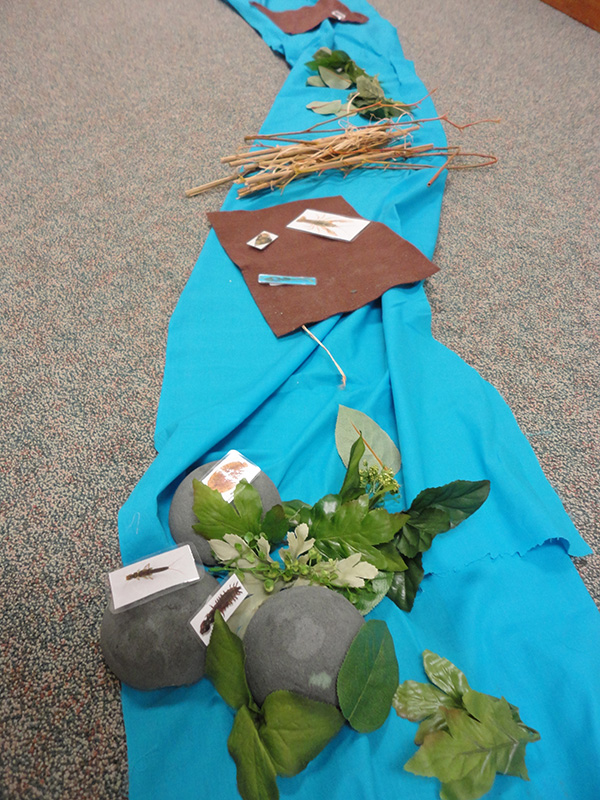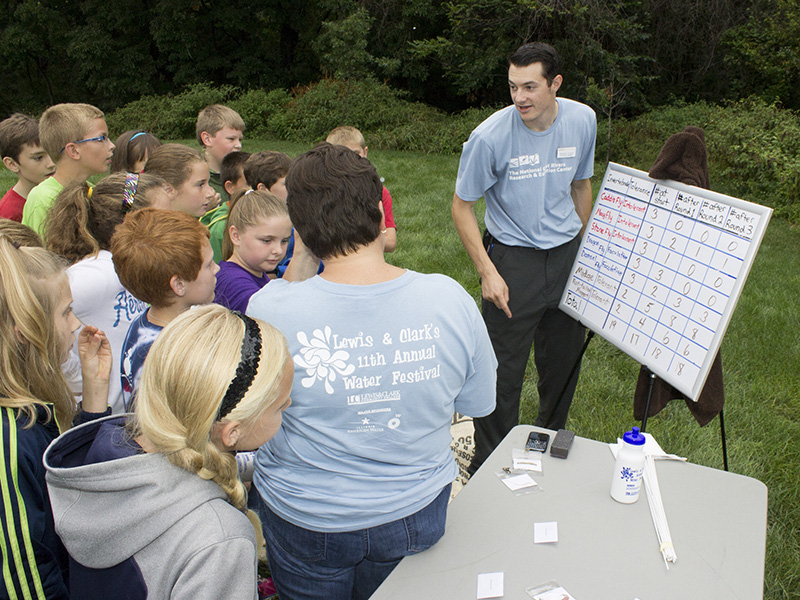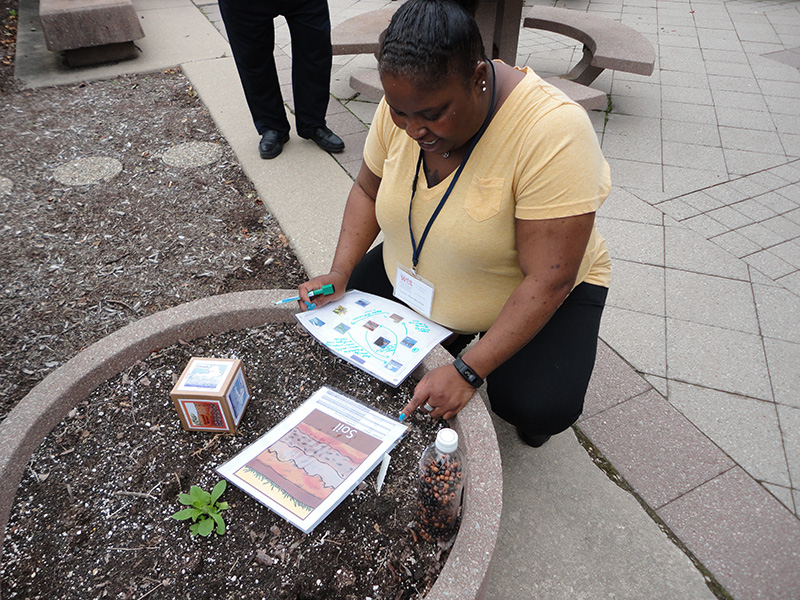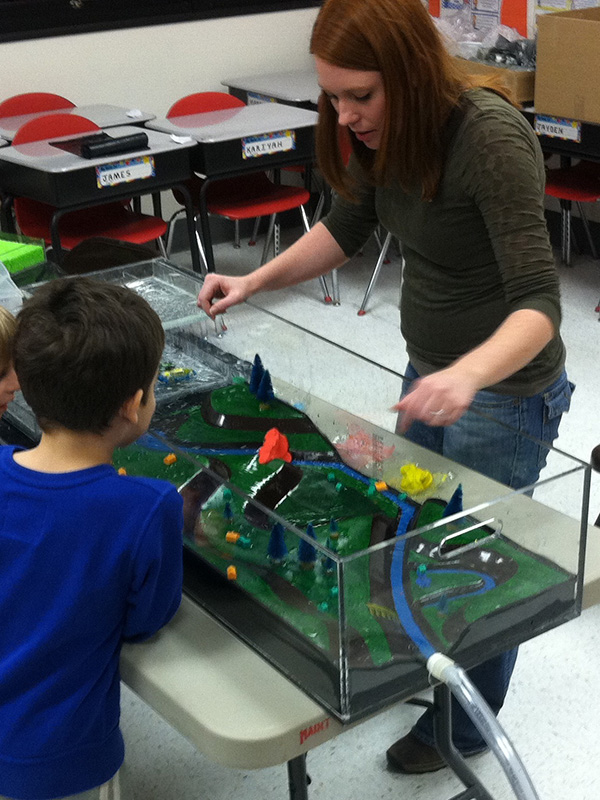Field Trips at NGRREC
These are just a few of our main “go-to” activities, but we can and often do many other water related exercises as well. The activities featured here are the larger ones, which we are working to align with national learning standards. This process will be completed soon.
We love to tailor experiences to accommodate group size and topics currently be discussed in your classroom.
In-person field trips are now available upon request. We also have virtual learning opportunities and educational learning kits available. Please contact the education department to learn more.
Stream Discovery Indoor Stream
Grades 3 – 8 (Field Station or Classroom Activity)
Students will learn what a watershed is, what watershed(s) they are located in, and how pollution from several different regions can ultimately end up in the same place. We will then talk about what macroinvertebrates are, and how scientists are able to use these creatures to determine the condition of our fresh waters. Students will then collect laminated macroinvertebrate cards out of our mock stream and calculate the condition of the stream based on the macroinvertebrates they found. They will then compare their findings with other students and discuss the results.

Macro Mayhem (a Project WET activity)
Grades 3 – 8 (Classroom Activity – must have gym or outdoor space)
Students will learn how pollution affects aquatic macroinvertebrates (water bugs) by playing a special game of tag. Students will be running around as they role play the different bug groups found in streams. At the end of the game, students will be able to see the effects pollution had on their stream and they will learn how scientists use these bugs to monitor water quality.

We All Live Downstream
Grades K – 12 (Field Station or Classroom Activity)
K-2 Description
Students will stand in a line and pretend to be part of a stream. They will each be handed a piece of “pollution”, and as a tub of water passes them, they will throw their pollution into the water. We will stop every so often to check on the quality of the water as it gets dirtier and dirtier. By the time all students have thrown in their pollution, the water will be very dirty. We will then talk about who is responsible for polluting the river. We will talk about how, even though each of them only threw in a tiny piece of pollution, the water still ended up very dirty. This activity will prompt students to think about how a little bit adds up, and how everyone needs to do their part to help keep our waters clean.
3-8 Description
Students will be broken into groups, and each group will be assigned a land use type (agriculture, construction, residential, etc.). Students will brainstorm within their group and come up with the different types of pollution they think could potentially come from their land use type and end up in the local water source. A tub of water will then be passed around, and each group will be able to add their type of “pollution” to the water. We will stop every so often to check on the quality of the water as it gets dirtier and dirtier. We will discuss the ease of cleaning the water, and how before a certain point, to clean the water would actually be quite simple and cost effective. By the end, the water will be quite dirty and will cost a lot to clean up. We will then discuss how a little bit here and there can add to a big problem.
9-12 Description
Students will be broken into groups, and each group will be assigned a land use type (agriculture, construction, residential, etc.). Students will brainstorm within their group and come up with the different types of pollution they think could potentially come from their land use type and end up in the local water source. A tub of water will then be passed around, and each group will be able to add their type of “pollution” to the water. We will stop every so often to check on the quality of the water as it gets dirtier and dirtier. We will discuss the ease of cleaning the water, and how before a certain point, to clean the water would actually be quite simple and cost effective. By the end, the water will be quite dirty and will cost a lot to clean up. We will then discuss how a little bit here and there can add to a big problem. Students will then go back to the groups and brainstorm ways in which to prevent pollution runoff from their land use type. This could be changes in behavior or engineering alterations. *This second brainstorm activity can be done later with the teacher instead, depending on time constraints.*
Incredible Journey (a Project WET activity)
Grades 3 – 12 (Field Station or Classroom Activity)
Students will role play a water molecule as it journeys through the water cycle. Along the way, they will learn all the different places water can end up, and how it can get locked away for long periods of time in a glacier, flowing through the ocean, or in an aquifer. Students will learn about the complexities of the water cycle as they put together a water cycle bracelet. Each station they visit will have uniquely colored beads. At the end of the activity, their bracelet will tell the story of their journey.
Follow-up writing activity for elementary students
Teachers can have students write down their water molecule’s journey. By using their bracelet, they should be able to write out all the steps of their journey.
Follow-up writing activity for middle school and high school students
Teachers can have students write a fictional tale that follows their water molecule through its journey. This story could include other characters, plot twists, and more as they turn their bracelet into a fun story.
Follow-up science writing for high school students
Teachers can have their students write out the specific heat exchanges that would have to take place for each leg of their journey, particularly those legs where phase changes took place.

Enviroscape
Grades 3 – 12 (Field Station or Classroom Activity)
This model allows students to visualize how runoff from agricultural and urban landscapes ends up in our waterways. They will then be able to suggest changes that can be made to the model to reflect both behavioral and environmental modifications that may reduce the effects of runoff, and test to see if their suggestions made a difference.
.jpg)
Floodplain Simulation Model
Grades K-12 (Field Station Activity)
K-5 Description
This model helps students to visualize what land development does to influence runoff and flood levels. Students will have the opportunity to “make it rain” on the model, and observe flooding effects given different land use types, such as a parking lot versus a wetland. They will also be allowed to place “houses” within the model where they think they would like to live. If certain homes are flooded, they will be able to suggest engineering certain infrastructure (such as a dam or a levee) to stop the flooding. They will then be able to see the after effects of their design, and re-evaluate.
6-12 Description
This model helps students to visualize what land development does to influence runoff and flood levels. Students will have the opportunity to “make it rain” on the model, and observe flooding effects given different land use types, such as a parking lot versus a wetland. They will also be allowed to place “houses” within the model where they think they would like to live. If certain homes are flooded, they will be able to suggest engineering certain infrastructure (such as a dam or a levee) to stop the flooding. They will then be able to see the after effects of their design, and re-evaluate. Students will also be prompted to consider the social and economic constraints of their proposed solutions.
Students can also work in teams to graph the results of flooding within the model. They will be able to track water levels over time, and plot this onto a computer. They can then compare and contrast graphs from different model scenarios and discuss the effects of land development near bodies of water. From these graphs, students will also be able to come up with an equation or function to fit the data and calculate rate of change.

A Note For Teachers
Activities are not always done the exact same way, with extra components being added or left out depending on time, the topic being discussed, the age group, or the staff member leading the activity. If there is a particular learning standard you want to make sure is touched on, or if there is a particular part of an activity description you would like us to focus on, please let us know that so that we can tailor your unique visit.